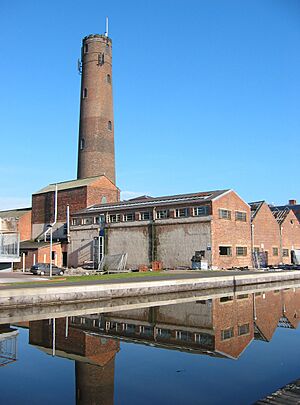Chester Shot Tower facts for kids
The Chester Shot Tower, also known as the Boughton Shot Tower, is a very old and special building in Chester, England. It's a type of building called a shot tower. This means it was used to make small lead balls, called lead shot. These were often used for muskets or shotguns.
The tower stands next to the Shropshire Union Canal. It was once part of a larger factory called the Chester Leadworks. Built in 1799 by a company named Walkers, Parker & Co., it is the oldest shot tower still standing in the UK. It might even be the oldest one in the whole world!
This round tower is made of red bricks. It stands about 41 meters (168 feet) tall. At its base, it is 9.1 meters (30 feet) wide. It gets narrower towards the top, where it is 6 meters (20 feet) wide. The tower has small arched windows. Inside, there is still a spiral staircase and old melting pots. A lift was added in 1971 but removed in 2020.
Contents
How Lead Shot Was Made
The Drop Process Explained
The Chester Shot Tower was one of the first to use a clever method for making lead shot. This method was invented in the 1780s by William Watts from Bristol.
Here's how it worked:
- Workers would melt lead at the top of the tower.
- They poured the hot, liquid lead through a special copper plate. This plate had many small holes, like a sieve.
- As the lead drops fell, they naturally formed perfect little spheres. This happens because of something called surface tension. It's like how water forms a round droplet.
- The spherical drops then fell into a vat of water at the bottom. This water quickly cooled them down.
Watts' method was much easier than the old way of casting each shot in a mould. The Chester tower was used early on to make lead shot for muskets during the Napoleonic Wars. Even though new ways to make shot were invented later, this tower was still in use until 2001.
Chester's Lead Industry History
Lead Mining and Trade in Chester
People believe that lead has been shipped from Chester's port since Roman times. This lead came from mines in north-east Wales. Later, places like Minera Lead Mines also supplied lead.
The building of the Chester Canal in the 1770s helped new factories grow. The Walkers, Parker & Co. leadworks was one of these, starting in the late 1700s. During the 1800s, the lead industry became very important for Chester.
In 2001, archaeologists studied the area. They found signs of many old buildings from the same time as the shot tower. By 1812, the leadworks also made lead pipes and sheets. The factory closed in 2001. Most of its buildings, except for the shot tower, were taken down around 2004. This made way for new developments along the canal.
Spheres of Reflection Park
A small park opened in May 2006 on part of the old factory site. The park has a cool sculpture made of shiny steel and blue glass. It's called 'Spheres of Reflection' by Edd Snell. This artwork was inspired by the lead drops hitting the water in the shot tower. It reminds everyone of Chester's lead industry past.
Other Shot Towers Around the World
The Chester Shot Tower is one of only three shot towers left in the UK. Many shot towers existed in the 1800s. For example, two appear in a famous painting by John Constable from 1832. But the Chester tower is the only one left from the 1700s or 1800s.
The two towers in Constable's painting were also owned by Walker, Parker & Co. One was built in 1782-83 by Mr. Watts, who invented the process. The other, the Lambeth shot tower, was built in 1826. Another Walker, Parker & Co. tower was in Elswick, near Newcastle upon Tyne. It was finished in 1797 and used until 1951.
Other old shot towers can be found in the United States. These include the Jackson Ferry Shot Tower (around 1807) in Virginia and the Sparks Shot Tower (1808) in Philadelphia.
The other two shot towers still standing in Britain are more modern. The Cheese Lane Shot Tower in Bristol was built in 1969. It replaced Watts' original tower, which was taken down in 1968. There's also a military lookout post in Tynemouth from 1916. People think it might have also been used as a shot tower.


